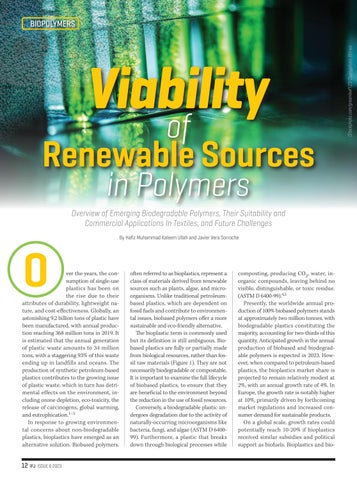Viability of
Renewable Sources in Polymers
Overview of Emerging Biodegradable Polymers, Their Suitability and Commercial Applications In Textiles, and Future Challenges
Heartland Polymers
O
ver the years, the consumption of single-use plastics has been on the rise due to their attributes of durability, lightweight nature, and cost-effectiveness. Globally, an astonishing 9.2 billion tons of plastic have been manufactured, with annual production reaching 368 million tons in 2019. It is estimated that the annual generation of plastic waste amounts to 34 million tons, with a staggering 93% of this waste ending up in landfills and oceans. The production of synthetic petroleum-based plastics contributes to the growing issue of plastic waste, which in turn has detrimental effects on the environment, including ozone depletion, eco-toxicity, the release of carcinogens, global warming, and eutrophication.1–3 In response to growing environmental concerns about non-biodegradable plastics, bioplastics have emerged as an alternative solution. Biobased polymers,
12 IFJ ISSUE 6 2023
By Hafiz Muhammad Kaleem Ullah and Javier Vera Sorroche
often referred to as bioplastics, represent a class of materials derived from renewable sources such as plants, algae, and microorganisms. Unlike traditional petroleumbased plastics, which are dependent on fossil fuels and contribute to environmental issues, biobased polymers offer a more sustainable and eco-friendly alternative. The bioplastic term is commonly used but its definition is still ambiguous. Biobased plastics are fully or partially made from biological resources, rather than fossil raw materials (Figure 1). They are not necessarily biodegradable or compostable. It is important to examine the full lifecycle of biobased plastics, to ensure that they are beneficial to the environment beyond the reduction in the use of fossil resources. Conversely, a biodegradable plastic undergoes degradation due to the activity of naturally-occurring microorganisms like bacteria, fungi, and algae (ASTM D 640099). Furthermore, a plastic that breaks down through biological processes while
composting, producing CO2, water, inorganic compounds, leaving behind no visible, distinguishable, or toxic residue. (ASTM D 6400-99).4,5 Presently, the worldwide annual production of 100% biobased polymers stands at approximately two million tonnes, with biodegradable plastics constituting the majority, accounting for two-thirds of this quantity. Anticipated growth in the annual production of biobased and biodegradable polymers is expected in 2023. However, when compared to petroleum-based plastics, the bioplastics market share is projected to remain relatively modest at 2%, with an annual growth rate of 4%. In Europe, the growth rate is notably higher at 10%, primarily driven by forthcoming market regulations and increased consumer demand for sustainable products. On a global scale, growth rates could potentially reach 10-20% if bioplastics received similar subsidies and political support as biofuels. Bioplastics and bio-
iStockphoto.com/greenleaf123/Duangphorn Wiriya
BIOPOLYMERS










